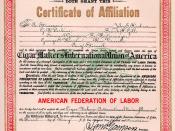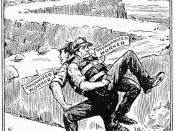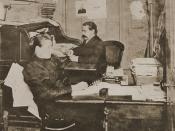Late 19th century America was a time of both prosperity and poverty. Although it is often remembered by the luxurious lives of those like the Rockefellers and Carnagies, the majority of the population was a struggling working class. Entire families worked for 10 hours a day, 7 days a week in dangerous, unsanitary factories just to have enough money for dinner and the issue of upgrading these working conditions quickly came to the forefront of American reforms. The movement towards organized labor from 1875-1900 was unsuccessful in improving the position of workers because of the initial failure of strikes, the inherent feeling of superiority of employers over employees and the lack of governmental support.
Since there was no groundwork to rationalize and show examples of the success of organized labor, it was nearly impossible to make it work at this time. If unions were going to work, striking would have to be effective and clearly, they weren't.
In the 1860's, the National Labor Union was formed to unify workers in fighting for higher wages, an 8 hour work day and various social causes and it set the stage for many failing unions to come. In 1877, railroad workers in this union from across the country took part in an enormous strike that resulted in mass violence and very few reforms1. Afterwards, a editorial in The New York Times stated: "the strike is apparently hopeless, and must be regarded as nothing more than a rash and spiteful demonstration of resentment by men too ignorant or too reckless to understand their own interests" (Document B). This editorial, which was clearly in favor of labor reforms, was acknowledging that this method of fighting was not going to work for the laborers at this time. A failure of this magnitude so early on in...


